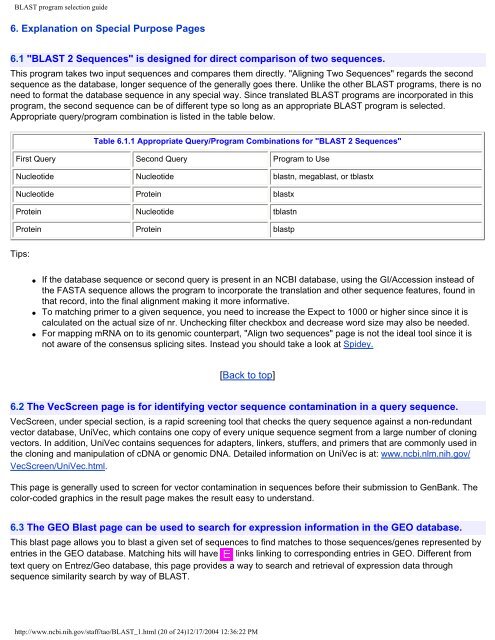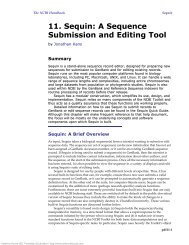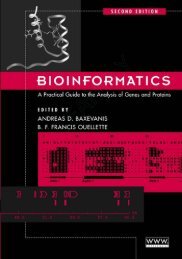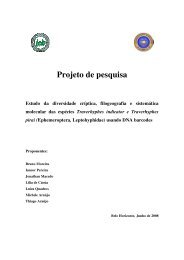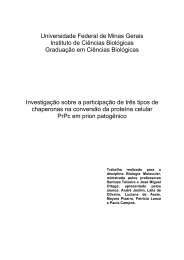BLAST program selection guide - Cromatina
BLAST program selection guide - Cromatina
BLAST program selection guide - Cromatina
You also want an ePaper? Increase the reach of your titles
YUMPU automatically turns print PDFs into web optimized ePapers that Google loves.
<strong>BLAST</strong> <strong>program</strong> <strong>selection</strong> <strong>guide</strong><br />
6. Explanation on Special Purpose Pages<br />
6.1 "<strong>BLAST</strong> 2 Sequences" is designed for direct comparison of two sequences.<br />
This <strong>program</strong> takes two input sequences and compares them directly. "Aligning Two Sequences" regards the second<br />
sequence as the database, longer sequence of the generally goes there. Unlike the other <strong>BLAST</strong> <strong>program</strong>s, there is no<br />
need to format the database sequence in any special way. Since translated <strong>BLAST</strong> <strong>program</strong>s are incorporated in this<br />
<strong>program</strong>, the second sequence can be of different type so long as an appropriate <strong>BLAST</strong> <strong>program</strong> is selected.<br />
Appropriate query/<strong>program</strong> combination is listed in the table below.<br />
Table 6.1.1 Appropriate Query/Program Combinations for "<strong>BLAST</strong> 2 Sequences"<br />
First Query Second Query Program to Use<br />
Nucleotide Nucleotide blastn, megablast, or tblastx<br />
Nucleotide Protein blastx<br />
Protein Nucleotide tblastn<br />
Protein Protein blastp<br />
Tips:<br />
●<br />
●<br />
●<br />
If the database sequence or second query is present in an NCBI database, using the GI/Accession instead of<br />
the FASTA sequence allows the <strong>program</strong> to incorporate the translation and other sequence features, found in<br />
that record, into the final alignment making it more informative.<br />
To matching primer to a given sequence, you need to increase the Expect to 1000 or higher since since it is<br />
calculated on the actual size of nr. Unchecking filter checkbox and decrease word size may also be needed.<br />
For mapping mRNA on to its genomic counterpart, "Align two sequences" page is not the ideal tool since it is<br />
not aware of the consensus splicing sites. Instead you should take a look at Spidey.<br />
[Back to top]<br />
6.2 The VecScreen page is for identifying vector sequence contamination in a query sequence.<br />
VecScreen, under special section, is a rapid screening tool that checks the query sequence against a non-redundant<br />
vector database, UniVec, which contains one copy of every unique sequence segment from a large number of cloning<br />
vectors. In addition, UniVec contains sequences for adapters, linkers, stuffers, and primers that are commonly used in<br />
the cloning and manipulation of cDNA or genomic DNA. Detailed information on UniVec is at: www.ncbi.nlm.nih.gov/<br />
VecScreen/UniVec.html.<br />
This page is generally used to screen for vector contamination in sequences before their submission to GenBank. The<br />
color-coded graphics in the result page makes the result easy to understand.<br />
6.3 The GEO Blast page can be used to search for expression information in the GEO database.<br />
This blast page allows you to blast a given set of sequences to find matches to those sequences/genes represented by<br />
entries in the GEO database. Matching hits will have links linking to corresponding entries in GEO. Different from<br />
text query on Entrez/Geo database, this page provides a way to search and retrieval of expression data through<br />
sequence similarity search by way of <strong>BLAST</strong>.<br />
http://www.ncbi.nih.gov/staff/tao/<strong>BLAST</strong>_1.html (20 of 24)12/17/2004 12:36:22 PM


